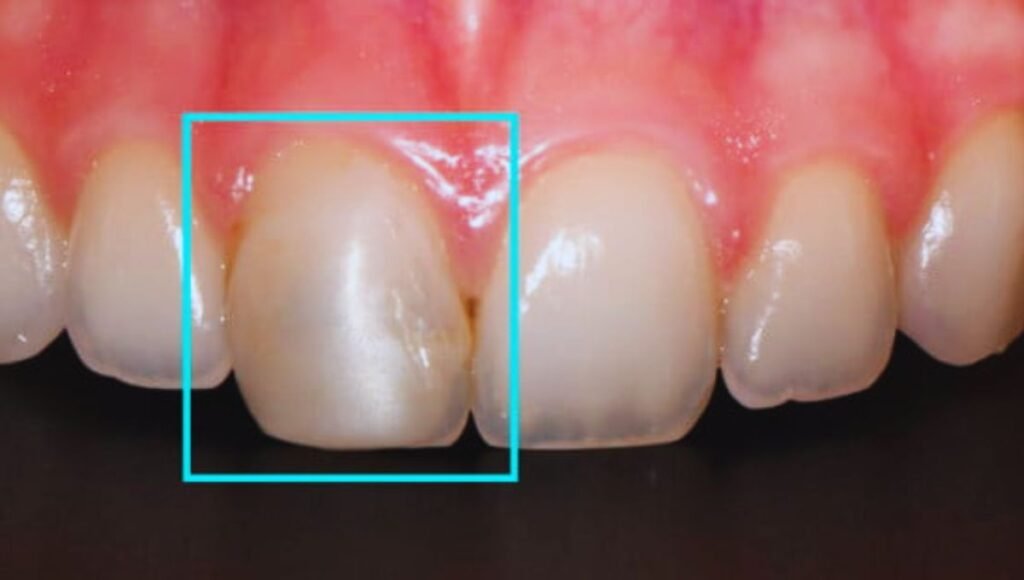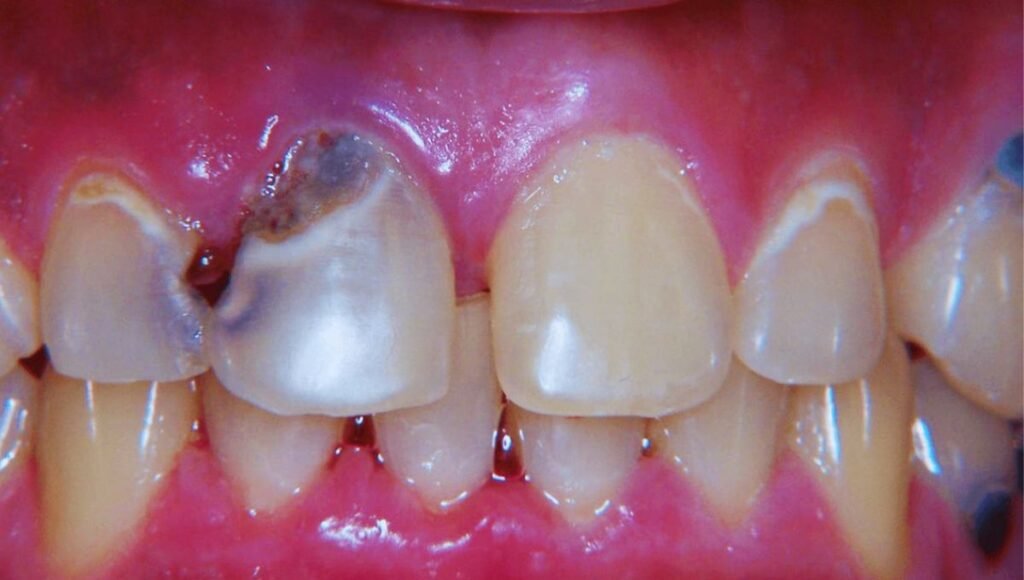How to Fix Cavity on Front Tooth?

If you’ve noticed a slight discoloration or a small pit on your front tooth, it’s likely you’re dealing with a cavity. While you might be tempted to dismiss it, especially if there’s no pain, ignoring it can lead to more serious issues down the line.
The treatment for a front tooth cavity can vary, ranging from simple fillings to more complex procedures, depending on the extent of decay. Before you decide on your next steps, it’s essential to understand the pros and cons of each option and how they impact not only your dental health but also your smile’s appearance. Why might a seemingly straightforward cavity require a nuanced approach? Let’s explore the implications.
Front teeth cavity treatment at home
Fixing a cavity on a front tooth is essential for both oral health and aesthetic reasons. Here’s a detailed guide on what you can expect during the process:
- Schedule a Dental Appointment:
- As soon as you notice signs of a cavity (such as pain, sensitivity, or visible decay), contact your dentist to schedule an appointment.
- Dental Examination and Diagnosis:
- Your dentist will perform a thorough examination of the affected tooth, possibly using X-rays to determine the extent of the cavity and to check for any underlying issues.
- Treatment Options:
- Fillings: For small to moderate cavities, the dentist will remove the decayed portion of the tooth and fill it with a tooth-colored composite resin. This material blends seamlessly with your natural tooth color, making the repair virtually invisible.
- Bonding: This procedure involves applying a tooth-colored resin to the cavity, then shaping and polishing it to match the rest of the tooth. Bonding is particularly useful for front teeth due to its natural appearance.
- Crowns: If the cavity is extensive and has weakened the tooth significantly, a crown (cap) may be necessary. The crown covers the entire visible part of the tooth, restoring its shape, strength, and appearance.
- Veneers: In some cases, especially for aesthetic purposes, a veneer (a thin shell of porcelain or composite) might be placed over the front surface of the tooth.
- Root Canal: If the cavity has reached the tooth’s pulp (inner nerve), a root canal may be needed to remove the infected tissue. After a root canal, the tooth is usually covered with a crown for protection and restoration.
- Post-Treatment Care:
- Follow your dentist’s aftercare instructions carefully. This may include avoiding certain foods, practicing good oral hygiene, and possibly using a fluoride rinse to help strengthen your teeth.
- Preventive Measures:
- Maintain Oral Hygiene: Brush your teeth at least twice a day with fluoride toothpaste, and floss daily to remove plaque and food particles.
- Healthy Diet: Limit sugary and acidic foods and drinks that can contribute to tooth decay. Opt for a balanced diet rich in vitamins and minerals.
- Regular Dental Check-ups: Visit your dentist regularly for check-ups and professional cleanings. Early detection and treatment of cavities can prevent more serious dental issues.
- Fluoride Treatments: Ask your dentist about fluoride treatments or sealants to help protect your teeth from cavities.
Summary: Fixing a cavity on a front tooth involves professional dental care to restore the tooth’s health and appearance. Options like fillings, bonding, crowns, or veneers can be used depending on the extent of the decay. Maintaining good oral hygiene, a healthy diet, and regular dental visits are crucial in preventing cavities and ensuring long-term dental health.
Identifying a Front Tooth Cavity
Recognizing a cavity in your front tooth often starts with noticing a visible discoloration or a minor change in texture. You might observe that the usual pearly white has developed a brown, black, or white spot that wasn’t there before. Sometimes, the surface of your tooth feels rougher, indicating a loss of enamel. These symptoms suggest that demineralization, a process where bacterial acids break down the tooth’s hard tissue, is occurring.
The causes of cavities, or dental caries, are multifaceted. Poor oral hygiene is a primary factor; if you don’t brush and floss regularly, plaque builds up and the bacteria within it produce acids that harm the tooth enamel. Dietary habits also play an essential role. Frequent consumption of sugary or acidic foods and drinks can accelerate enamel erosion, making your teeth more vulnerable to cavities.
Other symptoms to watch for include sensitivity to hot, cold, or sweet foods and drinks, as well as pain when biting down. This discomfort arises because the cavity allows stimuli to reach the nerves inside the tooth. If you’re experiencing any of these symptoms, it’s important to consult a dentist promptly to prevent further damage.

Home Remedies and Care
While consulting a dentist is the best course of action for a cavity, there are several home remedies and care techniques that can help manage symptoms and prevent further decay until professional treatment is available.
You can utilize natural remedies such as saltwater rinses to reduce bacterial growth and soothe discomfort. Simply dissolve a teaspoon of salt in a cup of warm water and swish it around your mouth for 30 seconds before spitting it out. This process can be repeated multiple times a day to maintain oral hygiene.
Another effective method involves the use of clove oil, known for its analgesic properties. Apply a small amount of clove oil on a cotton ball and dab it onto the affected tooth to alleviate pain. It’s essential, however, to use this sparingly, as excessive use can further irritate the gum tissue.
Diet changes also play a significant role in managing and preventing tooth decay. You should reduce your intake of sugary and acidic foods, which contribute to dental erosion. Instead, focus on consuming foods rich in calcium and phosphorus, such as dairy products, nuts, and leafy greens, which help remineralize tooth enamel and fortify teeth against cavities.
Professional Treatment Options
Dealing with a cavity in a front tooth typically requires professional dental care to restore oral health effectively. When the decay has penetrated deep into the tooth, affecting the nerve, a root canal may become necessary. This procedure involves removing the damaged nerve and pulp, cleaning the inner chambers, and sealing the tooth to prevent further infection.
Addressing these issues promptly is vital to avoid additional complications like abscesses or spread of infection.
For less severe cavities where the structure of the tooth remains largely intact, a composite filling is often the preferred choice. This treatment involves removing the decayed portion of the tooth and then filling it with a composite resin.
This material is favored for front teeth due to its ability to closely match the color of your natural teeth, ensuring a cosmetic restoration that doesn’t compromise the appearance of your smile.
Both treatments are carried out under local anesthesia to minimize discomfort. Your dentist will select the appropriate method based on the extent of decay and the condition of your tooth. Following their recommendations is crucial to preserve the strength and health of your tooth, ensuring a functional and aesthetic outcome.
Aftercare and Monitoring

Once your cavity treatment is completed, it’s important to follow your dentist’s aftercare instructions to ensure proper healing and prevent future issues. Adhering to effective brushing techniques not only enhances enamel protection but also assists in maintaining the integrity of your dental restoration. Use a soft-bristled toothbrush and gentle, circular motions to avoid aggravating the treated area.
In addition to proper brushing, modifying your diet plays a pivotal role in the health of your repaired tooth. Limit sugary and acidic foods that can erode enamel and undermine the durability of your dental work. Instead, opt for foods rich in calcium and phosphate to support enamel remineralization.
Regular follow-up visits are essential to guarantee that your tooth is healing correctly and to assess the ongoing health of your gums and adjacent teeth. During these visits, your dentist can provide further guidance on oral hygiene practices and make any necessary adjustments to your treatment plan.
Here’s a brief overview to help you remember the key points:
| Focus Area | Recommendations |
|---|---|
| Brushing Techniques | Use soft-bristled toothbrush, gentle motions |
| Dietary Changes | Avoid sugars and acids, choose calcium-rich foods |
| Enamel Protection | Follow brushing guidance, attend regular check-ups |
| Follow-up Visits | Schedule routinely, adjust care as needed |
Preventing Future Cavities
Implementing effective preventive measures can greatly reduce your risk of developing future cavities on your front tooth. Maintaining robust oral hygiene is essential. You should brush at least twice a day using fluoride toothpaste, which helps in remineralizing tooth enamel and preventing decay.
Don’t forget to floss daily; it removes plaque and food particles from areas your toothbrush can’t reach, particularly around your front teeth which are more exposed and susceptible to cavities.
Incorporating diet control is equally vital. Limit your intake of sugary and acidic foods and beverages, as these can erode tooth enamel and promote cavity formation. Instead, opt for foods rich in calcium and phosphates, like dairy products and leafy greens, which can help strengthen tooth enamel.
Additionally, drinking plenty of water throughout the day helps rinse away food particles and bacteria, reducing the risk of cavities.
Regular dental check-ups are essential. Visit your dentist at least twice a year for professional cleanings and to monitor the health of your teeth and gums. Early detection of potential issues can prevent them from escalating into more serious problems.
Frequently Asked Questions
Can a Cavity Change the Color of My Front Tooth?
Yes, a cavity can cause tooth discoloration, turning your tooth darker. You’ve got cosmetic options to explore, such as whitening or veneers, to restore the natural appearance of your tooth.
Will Fixing a Cavity Affect My Tooth Sensitivity?
Fixing a cavity may initially increase your tooth sensitivity, but proper sensitivity management and maintaining good oral hygiene can mitigate this. Typically, tooth sensitivity decreases as the tooth adjusts to the cavity filling.
How Quickly Can a Cavity on a Front Tooth Progress?
A cavity on your front tooth can progress quickly depending on your oral hygiene and diet. Regular check-ups and timely treatment are essential to prevent rapid decay and maintain peak dental health.
Are There Any Dietary Changes to Help Heal a Front Tooth Cavity?
To aid the healing process, you should adjust your diet to include calcium-rich foods and reduce sugars. Enhancing oral hygiene with fluoride toothpaste can also prevent further decay and support cavity healing.
Can a Front Tooth Cavity Cause Bad Breath?
Yes, a cavity in your front tooth can cause bad breath due to bacteria buildup. Maintaining oral hygiene and exploring filling options are essential to address this issue and prevent further complications.
Conclusion
To wrap up, if you’re dealing with a front tooth cavity, it’s important to consult your dentist promptly. They’ll assess the extent of decay and recommend the best treatment, whether it’s a simple filling or a more involved root canal.
After the procedure, follow their aftercare instructions closely, maintain strict oral hygiene, and keep up with regular dental check-ups to guarantee successful healing and prevent future cavities.
Remember, early intervention is essential to preserving your smile and oral health.